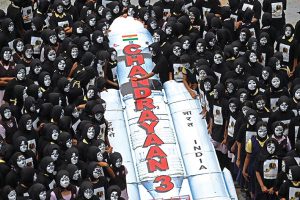BLOOMBERG
India became the first country to land a spacecraft near the moon’s south pole after Russia’s attempt at a lunar touch down in the same area ended in failure following an engine malfunction. Chandrayaan-3 — India’s spacecraft that launched last month — achieved a soft landing at 6:04 pm local time on August 23, after Russia’s Luna-25 crashed into the moon. A rover, named Pragyan, or wisdom, is set to analyse the chemical makeup of the moon’s surface and search for water over the course of one lunar day, which is equivalent to 14 days on Earth.
India is the second country, along with China, to have an operating rover on the moon. A successful touch down lifts India’s prestige in the global space race, after the country suffered a setback from a failed moon mission in 2019. Prime Minister Narendra Modi wants to bolster the country’s place among the world’s space faring nations and in June India signed the Artemis Accords, a US-backed initiative with more than two dozen other countries to govern joint missions and civilian space exploration.
Vikram, Chandrayaan-3’s lander, had been trending on X, formerly known as Twitter, as billionaire industrialists and Bollywood actors eagerly awaited the historic moment. Schools urged students across the world’s most-populous nation to watch the live event and commemorate the landmark mission, while some prayed in mosques and temples for a successful landing.
Shares of 13 Indian space-sector companies, including PTC Industries, Zen Technologies and Centum Electronics, rallied and added more than $2.5 billion in market value this week, according to data complied by Bloomberg.
The water ice present in the moon’s unchartered south pole has also piqued the interest of space voyaging countries, including the US and China. It could be a crucial drinking, breathing and rocket fuel resource to advance human space exploration deeper into the solar system.
In a social media post, Nasa Administrator Bill Nelson congratulated India on being “the 4th country to successfully soft-land a spacecraft on the Moon.”
The US plans to send the first humans to explore the area near the south pole in 2025, in a mission called Artemis III. China is also seeking to build a research station near the region and place astronauts on the moon by 2030. Japan has an uncrewed mission planned for launch on August 26.
India has other space efforts slated. The country will soon launch a mission, called Aditya L1, for a detailed solar study. A Venus mission is also on the Indian Space Research Organisation’s agenda, Modi said after the landing. The agency plans to demonstrate human spaceflight capability through its Gaganyaan mission, which will launch crew members into an orbit of 400 kilometers (249 miles) for three days before bringing them back safely to Earth.
India’s space agency and Nasa have agreed to send an Indian astronaut to the International Space Station. The South Asian nation is also in discussions with Japan to work on a moon mission together.
 The Gulf Time Newspaper One of the finest business newspapers in the UAE brought to you by our professional writers and editors.
The Gulf Time Newspaper One of the finest business newspapers in the UAE brought to you by our professional writers and editors.
